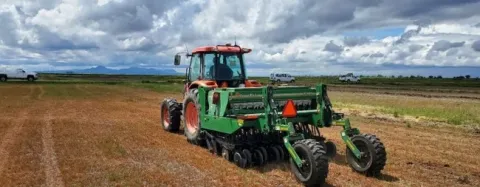As I write this in early April, the weather is shifting back and forth between being warm and cold and there is the occasional rainfall. Many of you have started or are thinking about starting ground work in preparation for planting. With all this going on, I ask you to imagine what it would be like for your farming operations if you could plant a rice field in mid-April. Later this week, we are planning to plant our first research plots on a summer stale-seedbed (fallowed last year and worked in the summer into a seedbed) using a no-till planter. The ground is firm enough to support equipment, we have taken care of our winter weeds and the seed will be planted into moisture. On top of that, we have rain in the forecast for the weekend. Once planted, these rainfall events are helpful.
If the soil is dry, how early one can plant really depends on temperature. Daily average temperature (average of daily minimum and maximum) should be 60oF. Historically, this average falls between April 10 and 15 in the Sacramento Valley. The other consideration if you are planting early is the availability of water. The seeds need to have water to germinate. You cannot always rely on rainfall. Sometimes it may be hard to plant to moisture. In these cases, you need irrigation water. If you have an irrigation pump, you are free to decide when to plant and irrigate your field. If you have to rely on district water, you will be more restricted in your planning.
Last year, we conducted a pilot study of these systems and the results were very encouraging. Yields were similar to water seeded conventional systems. This year we are testing these no-till systems at the Rice Experiment Station in a more rigorous experiment. We are examining the importance of using a seed treatment (gibberellic acid - GA) for more rapid seedling emergence, weed management programs (Whitney) and how best to manage nitrogen fertilizers. Luis will also examine the impact on pests and diseases. We are comparing three systems to a water seeded conventional practice. The three treatments are: (1) no-till drill seeding into a summer stale seedbed (fallowed last year and worked in the summer); (2) no-till drill seeding into a field that had rice last year but the rice straw was removed (3) no-till drill seeding into a field that has rice last year but the straw was chopped and left on the surface. We will be planting each of these treatments when it is possible to run a no-till drill across them. We expect to plant them in the order the treatments are listed. The treatment with the chopped straw mat holds in a lot of soil moisture which delays planting. However last year, we observed that the mat also helps a lot with weed control.
If you are interested in seeing this experiment, we will be having a field day on June 18 at the Rice Experiment Station (details will follow). You will also be able to see this experiment at the Annual Rice Field Day on August 28.


